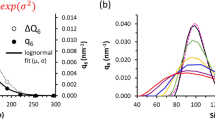Abstract
StepScan DSC technique was used for the study of the glass transition phenomenon. This method allows relatively good monitoring of reversing and non-reversing processes, and thus is very useful tool for glass transition studies of wide type of glass-forming materials, including inorganic glasses as well as organic polymers. In this work, experience with the StepScan DSC technique is summarized. Some interesting results of its application are presented, such as determination of glass transition temperature independent on thermal history of glass, discovered relationship between the slope of temperature dependence of C p in T g, and Angel’s index of fragility and estimation of viscosity glass transition temperature, T g,η.







Similar content being viewed by others
References
Tammann G. Der Glasszustand. Section IV. Leipzig: Verlag L.Voss; 1933. p. 12.
Rao KJ. Structural chemistry of glasses. 1st ed. Oxford: Elsevier; 2002. p. 77.
Brawer S. Relaxation in viscous liquids and glasses. Columbus: The American Ceramics Society; 1985. p. 17.
Chromčíková M, Liška M. Simple relaxation model of the reversible part of the StepScan® DSC record of glass transition. J Therm Anal Calorim. 2006;84:703–8.
Boerio-Goates J, Callanan JE. Differential thermal methods. In: Rossiter BW, Baetzold RC, editors. Physical methods of chemistry: determination of Thermodynamic properties. vol. 6, 2nd ed. New York: Wiley; 1992. p. 655.
Certificate of viscosity values, Standard sample no. 711 lead-silica glass, U.S. Department of Commerce, National Bureau of Standards, Washington, D.C. 20235; 1964.
Moynihan CT. Structural relaxation and the glass transition. In: Stebbins JF, McMillan PF, Dingwell DB, editors. Reviews in mineralogy: structure, dynamics and properties of silicate melts. vol. 32. Washington, DC: Mineralogical Society of America; 1995. pp. 1–19.
Černošek Z, Holubová J, Černošková E, Liška M. Enthalpic relaxation and the glass transition. J Optoelectron Adv Mater. 2002;4:489–503.
Černošek Z, Holubová J, Černošková E. Non-isothermal structural relaxation and the glass transition temperature. Solid State Sci. 2003;5:1087–93.
Černošek Z, Holubová J, Černošková E. Capability of conventional differential scanning calorimetry (DSC), temperature modulated DSC (MDSC) and StepScan DSC for the glass transition phenomenon study. Optoelectron Adv Mater-Rapid Commun. 2007;1:277–80.
Holubová J, Černošek Z, Černošková E. The study of the glass transition by the StepScan DSC technique. J Optoelectron Adv Mater. 2005;7:2671–6.
Angell CA. Relaxation in liquids, polymers and plastic crystals: strong/fragile patterns and probléme. J Non-Cryst Solids. 1991;131–133:13–31.
Angell CA. Formation of glasses from liquids and biopolymers. Science. 1995;267:1924–35.
Böhmer R, Ngai K, Angell CA, Plazek DJ. Nonexponential relaxations in strong and fragile glass formers. J Chem Phys. 1993;99:4201–9.
Speedy RJ. Relations between liquid and its glasses. J Phys Chem B 1999;103:4060–4065.
Ito K, Moynihan CT, Angell CA. Thermodynamic determination of fragility in liquids and a fragile to strong liquid transition in water. Nature. 1999;398:492–5.
Ngai KL, Yamamuro O. Thermodynamic fragility and kinetic fragility in supercooled liquids: a missing link. J Chem Phys. 1999;111:10403–6.
Martinez LM, Angell CA. A thermodynamic connection to the fragility of glass-forming liquids. Nature. 2001;410:663–7.
Acknowledgements
This work was supported by the project MSM 0021627501of the Ministry of Education, Youth and Sport of the Czech Republic.
Author information
Authors and Affiliations
Corresponding author
Rights and permissions
About this article
Cite this article
Holubová, J., Černošková, E. & Černošek, Z. StepScan DSC. J Therm Anal Calorim 111, 1633–1638 (2013). https://doi.org/10.1007/s10973-012-2417-0
Received:
Accepted:
Published:
Issue Date:
DOI: https://doi.org/10.1007/s10973-012-2417-0




